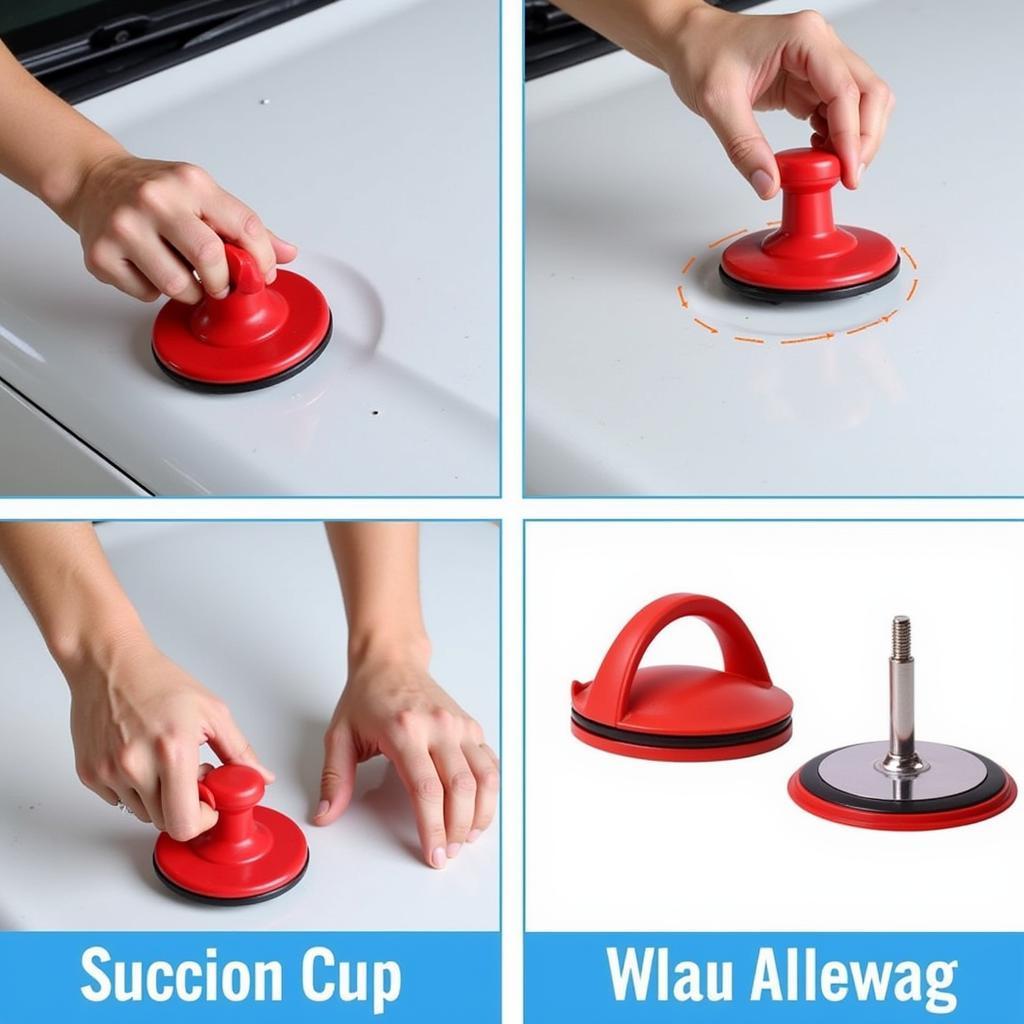Fixing a dent in your car roof can seem daunting, but with the right approach, you can often repair it yourself or find a cost-effective professional solution. This guide will walk you through various methods for How To Repair A Dent In Car Roof, from DIY fixes to professional repairs, empowering you to make the best decision for your situation.
Understanding the Dent: Size, Depth, and Location
Before attempting any repair, assess the dent’s size, depth, and location. Small, shallow dents often respond well to DIY methods like paintless dent repair (PDR) or suction cup techniques. Deeper dents or those with creases might require more advanced methods like body filler and repainting. The location of the dent on the roof can also influence the repair method. Dents near the edges might be more accessible for PDR, while those in the center might require different tools and techniques.
Can’t decide whether to DIY or call a pro? Check out this helpful resource: can i repair my own car after filing a claim. It offers valuable insights to help you make an informed decision.
DIY Dent Repair Methods for Your Car Roof
Several DIY methods can effectively address minor dents in your car roof:
- Suction Cup Method: Use a suction cup dent puller to gently pull the dent outwards. This method works best on shallow dents without creases.
- Hot Glue and Dowel Method: Apply hot glue to dowels, attach them to the dent, and gently pull outwards after the glue cools. This method provides more pulling power than suction cups.
- Hair Dryer and Compressed Air Method: Heat the dented area with a hairdryer, then quickly apply compressed air (inverted can). The rapid temperature change can sometimes pop the dent back into place. This method is most effective on plastic components and less so on metal car roofs.
 Car roof dent repair using a suction cup
Car roof dent repair using a suction cup
Professional Dent Repair Options
For more significant damage, professional repair is recommended:
- Paintless Dent Repair (PDR): A skilled technician uses specialized tools to massage the dent out from behind the panel, preserving the original paint. This is often the preferred method for dents without paint damage.
- Traditional Bodywork: For deeper dents or those with paint damage, traditional bodywork involves filling the dent with body filler, sanding, priming, and repainting.
Choosing the Right Repair Method
Selecting the appropriate method depends on several factors:
- Dent Size and Depth: Small, shallow dents are ideal for DIY or PDR. Larger, deeper dents usually require traditional bodywork.
- Paint Damage: If the paint is damaged, traditional bodywork is likely necessary.
- Your Budget: DIY methods are generally the most affordable, while PDR falls in the mid-range, and traditional bodywork can be the most expensive.
- Your Skill Level: If you’re not comfortable with DIY repairs, it’s best to leave it to the professionals.
 Professional PDR car roof dent removal
Professional PDR car roof dent removal
“When assessing a car roof dent, always consider the underlying structure. A seemingly minor dent can sometimes hide more extensive damage,” advises John Miller, Senior Auto Body Technician at Miller’s Auto Repair.
How Much Does it Cost to Repair a Dent in a Car Roof?
The cost to repair a car roof dent can vary significantly based on the severity of the damage and the chosen repair method. DIY methods are the cheapest, ranging from $10 to $50 for materials. PDR typically costs between $100 and $300, while traditional bodywork can range from $300 to $1000 or more.
Do you want to handle the repair yourself? Knowing your options after filing a claim can be helpful: can i repair my own car after filing a claim.
Preventing Future Car Roof Dents
While not all dents are preventable, some precautions can minimize the risk:
- Park Carefully: Avoid parking under trees or in areas prone to falling objects.
- Be Mindful of Overhead Clearance: Be aware of low-hanging branches or other obstacles when driving.
- Consider a Car Cover: A car cover can protect your car from hail, falling debris, and other potential hazards.
 Preventing car roof dents by parking carefully
Preventing car roof dents by parking carefully
Conclusion
Repairing a dent in your car roof doesn’t have to be a major headache. By understanding the various repair options and assessing the damage carefully, you can choose the best approach for your situation and restore your car’s appearance. Remember to consider factors like dent size, paint damage, your budget, and your skill level when making your decision. How to repair a dent in car roof effectively depends on these key factors.
FAQ
- Can I repair a large dent in my car roof myself? While possible, large dents often require professional expertise for optimal results.
- Will PDR work on all types of dents? PDR is most effective on shallow dents without creases or paint damage.
- How long does PDR typically take? PDR can often be completed within a few hours, depending on the dent’s complexity.
- Is it necessary to repaint the roof after PDR? No, PDR preserves the original paint, eliminating the need for repainting.
- What type of body filler should I use for car roof repair? Use a high-quality automotive body filler designed for metal surfaces.
- How can I prevent hail damage to my car roof? Park in a covered area or use a car cover during hailstorms.
- How do I find a reputable PDR technician? Seek recommendations from trusted sources or check online reviews.
“PDR is a fantastic option for many car roof dents, but it’s essential to choose a qualified technician with a proven track record,” says Maria Sanchez, Lead PDR Technician at Dent Solutions.
Need support? Contact us via WhatsApp: +1(641)206-8880, Email: [email protected]. We have a 24/7 customer support team.


